The human iris, with its intricate patterns and unique coloration, has long fascinated both medical professionals and alternative health practitioners. Beyond determining your eye color, some believe the iris holds valuable information about your overall health. Iridologia suggests that specific markings, colors, and patterns in your iris can reveal information about your body’s past, present, and potential future health conditions. This practice has gained attention as a non-invasive method for health assessment, though it remains controversial in conventional medical circles.
In this comprehensive guide, we’ll explore the scientific foundations of Iridologia, examining both historical perspectives and modern research. We’ll delve into how practitioners map iris patterns to organ systems, the anatomy behind these connections, and the ongoing debate about its validity as a diagnostic tool. Whether you’re a healthcare professional, alternative medicine practitioner, or simply curious about holistic approaches to health assessment, this article provides an evidence-based exploration of Iridologia‘s principles and applications.
What Is Iridologia? A Historical and Modern Perspective
Iridologia is an alternative medicine practice that involves examining the patterns, colors, and other characteristics of the iris to evaluate a person’s overall health. Practitioners of Iridologia, known as iridologists, believe that each area of the iris corresponds to a specific organ or body system, and that changes in these areas can reflect changes in the health of the corresponding body parts.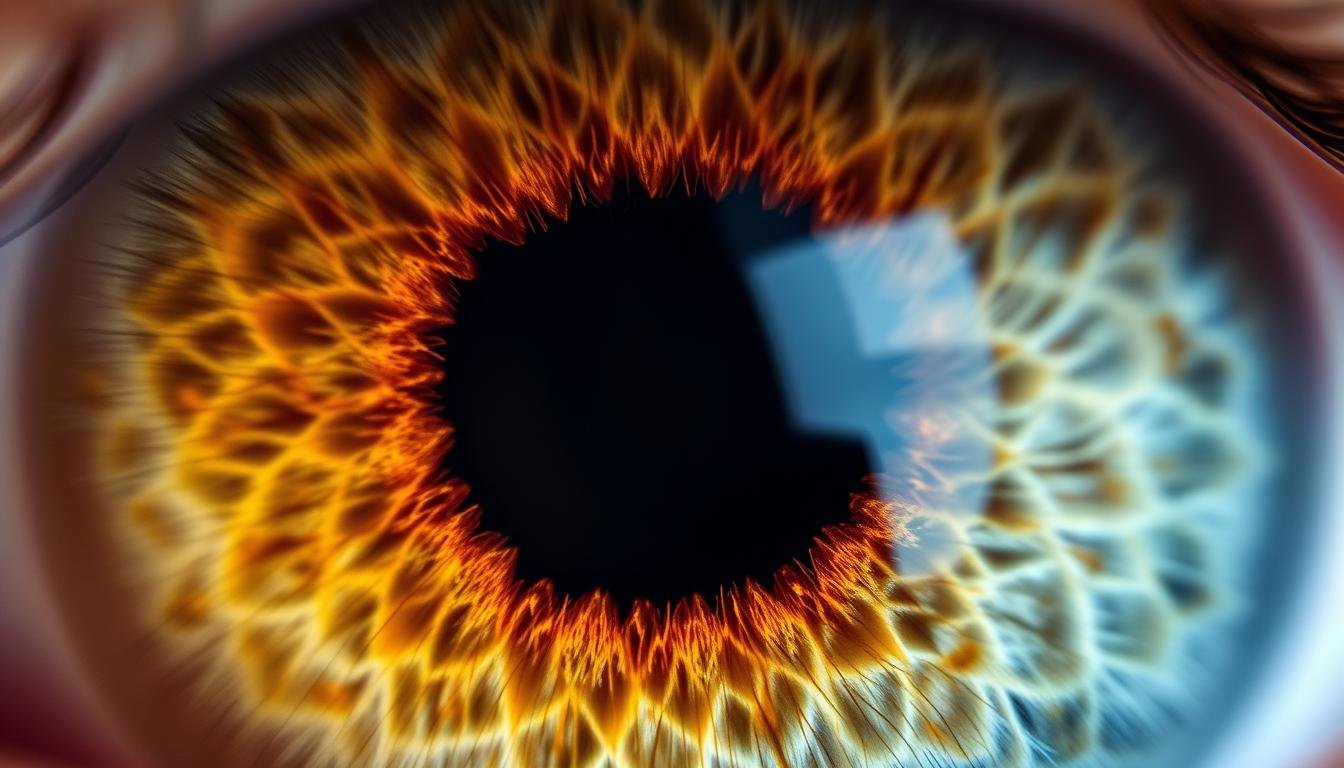
The intricate patterns of the human iris that iridologists analyze for health assessment
The core premise of Iridologia is that the iris serves as a “mappa” of the body, with different zones corresponding to different organs and systems. According to this theory, when an organ or system experiences stress, inflammation, or other health issues, corresponding changes appear in the iris. These changes might include spots, lines, discolorations, or structural alterations that an iridologist interprets to assess your health status.
Historical Development of Iridologia
While some proponents claim that forms of iris examination date back to ancient civilizations in Egypt, China, and India, modern Iridologia as we know it today began to take shape in the 19th century.

Ignaz von Peczely, the Hungarian physician considered the father of modern iridology
The foundations of modern Iridologia are often attributed to Ignaz von Peczely, a Hungarian physician in the 1800s. According to popular accounts, as a child, von Peczely noticed a dark streak in the iris of an owl whose leg he had accidentally broken. This observation sparked his curiosity, and he later developed the theory that changes in the iris could reflect injuries or diseases in corresponding parts of the body.
In 1881, von Peczely published his first book on the subject, “Discoveries in the Field of Natural Science and Medicine: Instruction in the Study of Diagnosis from the Eye,” which included the first known iris chart mapping different areas of the iris to various body parts.
Another significant figure in the development of Iridologia was Nils Liljequist, a Swedish homeopath who independently developed similar theories around the same time. Liljequist claimed to have observed changes in his own iris after taking medications like quinine and iodine, which led him to create his own iris charts.
In the United States, Iridologia gained popularity in the 1950s through the work of Bernard Jensen, an American chiropractor who developed his own method of iris analysis and created detailed iris charts that are still used by many practitioners today. Jensen’s work helped popularize Iridologia as part of the broader natural health movement in America.
The Science Behind Iridologia: Mapping Iris Patterns to Organ Systems
The practice of Iridologia is based on the premise that the iris contains a wealth of information about the body’s health. Understanding the methodology and tools used by iridologists provides insight into how this practice is conducted and the scientific principles it claims to follow.
Iris Anatomy and Its Relevance to Iridologia
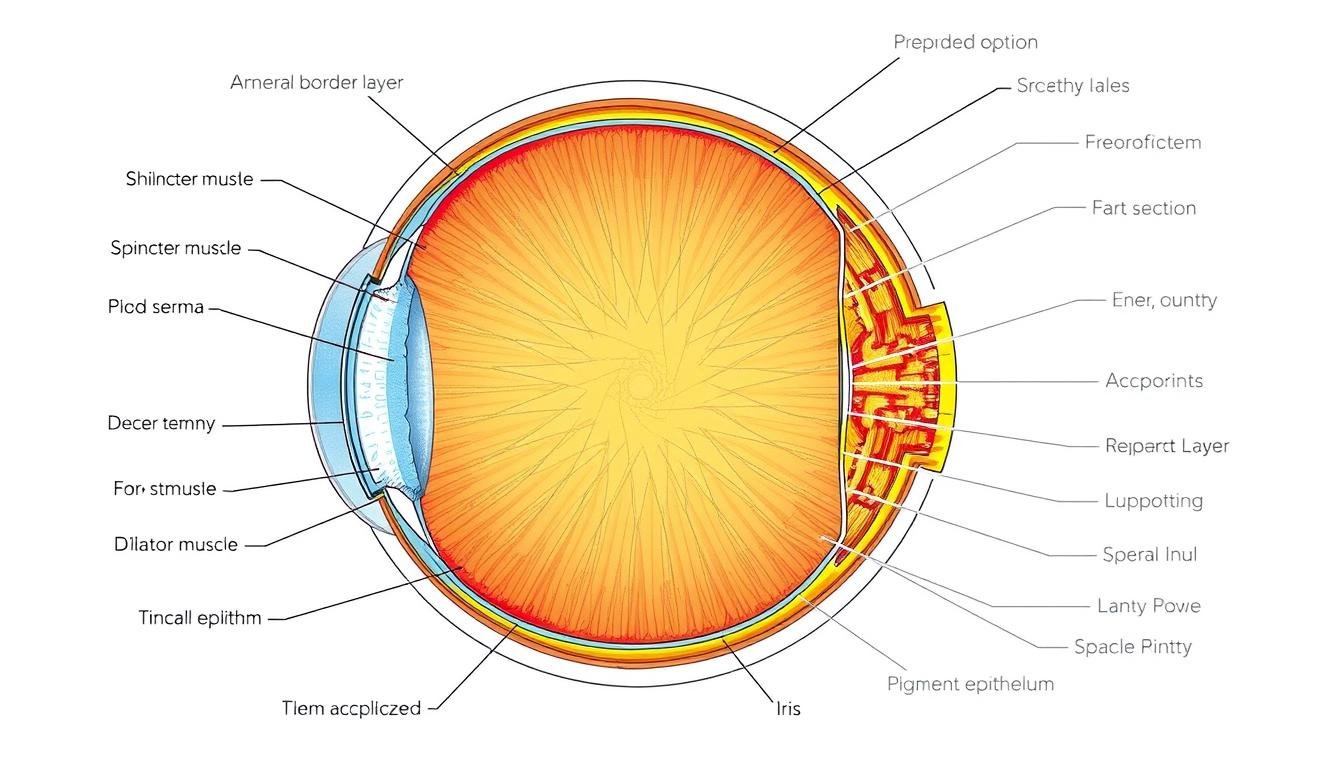
Anatomical structure of the iris showing the various layers examined in iridology
The iris is a complex structure composed of multiple layers and features:
- The anterior border layer (the front surface visible during examination)
- The stroma (connective tissue with blood vessels, nerves, and muscle fibers)
- The sphincter and dilator muscles (controlling pupil size)
- The posterior epithelium (containing pigment that gives the iris its color)
Iridologists believe that the iris’s intricate structure, with its thousands of nerve endings, microscopic blood vessels, and muscle fibers, creates a unique connection to the rest of the body through the nervous system. According to Iridologia theory, this neurological connection allows the iris to reflect changes in distant organs and tissues.
IL Iridologia Chart: Mapping the Body
The cornerstone of Iridologia practice is the iris chart, which divides the iris into approximately 60 zones, each corresponding to a different part of the human body. These charts typically follow a few key principles:
Structural Organization
- The right iris generally corresponds to the right side of the body
- The left iris generally corresponds to the left side of the body
- The iris is divided into concentric zones representing different body systems
- The chart is often organized like a clock face, with organs and systems positioned at specific “hours”
Interpretation Elements
- Color variations and pigmentation changes
- Structural features like fibers, rings, and crypts
- Lesions, spots, and other markings
- Pupil characteristics and reactions
Enhance Your Understanding of Iris Analysis
Download our comprehensive iridology chart and beginner’s guide to start learning how to identify key iris patterns and their potential health correlations.
Scarica grafico IRIDOLOGIA GRATUITO
Examination Tools and Techniques
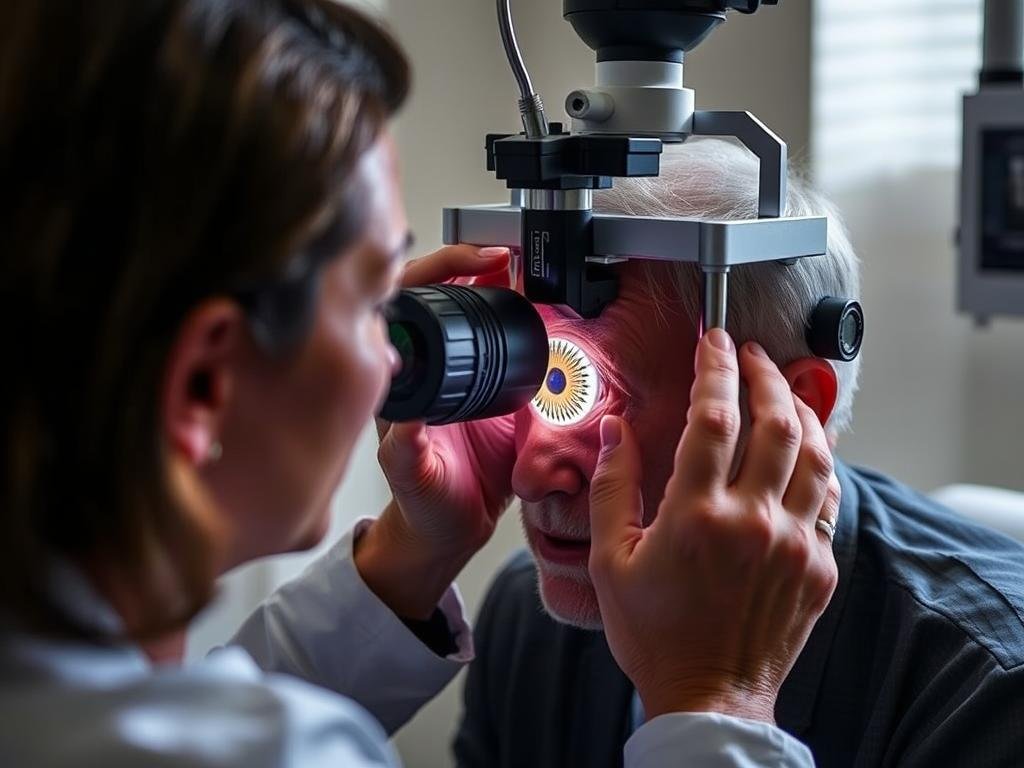
An iridologist conducting an examination using specialized equipment
Modern iridologists typically use several tools to conduct their examinations:
- Penlight or flashlight to illuminate the iris
- Magnifying glass or loupe for closer inspection
- Digital cameras with macro lenses for detailed photography
- Specialized iris cameras designed specifically for iridology
- Computer software for analyzing iris photographs
During an examination, the iridologist first takes a detailed look at both irises, noting their overall color, structure, and any visible markings. They may take photographs to analyze later or use computer software that helps identify patterns and compare them to established iridology charts.
Health Conditions Identified Through Iridologia
Practitioners of Iridologia claim they can identify a wide range of health conditions and predispositions by examining the iris. While these claims lack scientific validation in conventional medicine, understanding what iridologists believe they can detect helps explain the practice’s appeal to those interested in holistic health approaches.
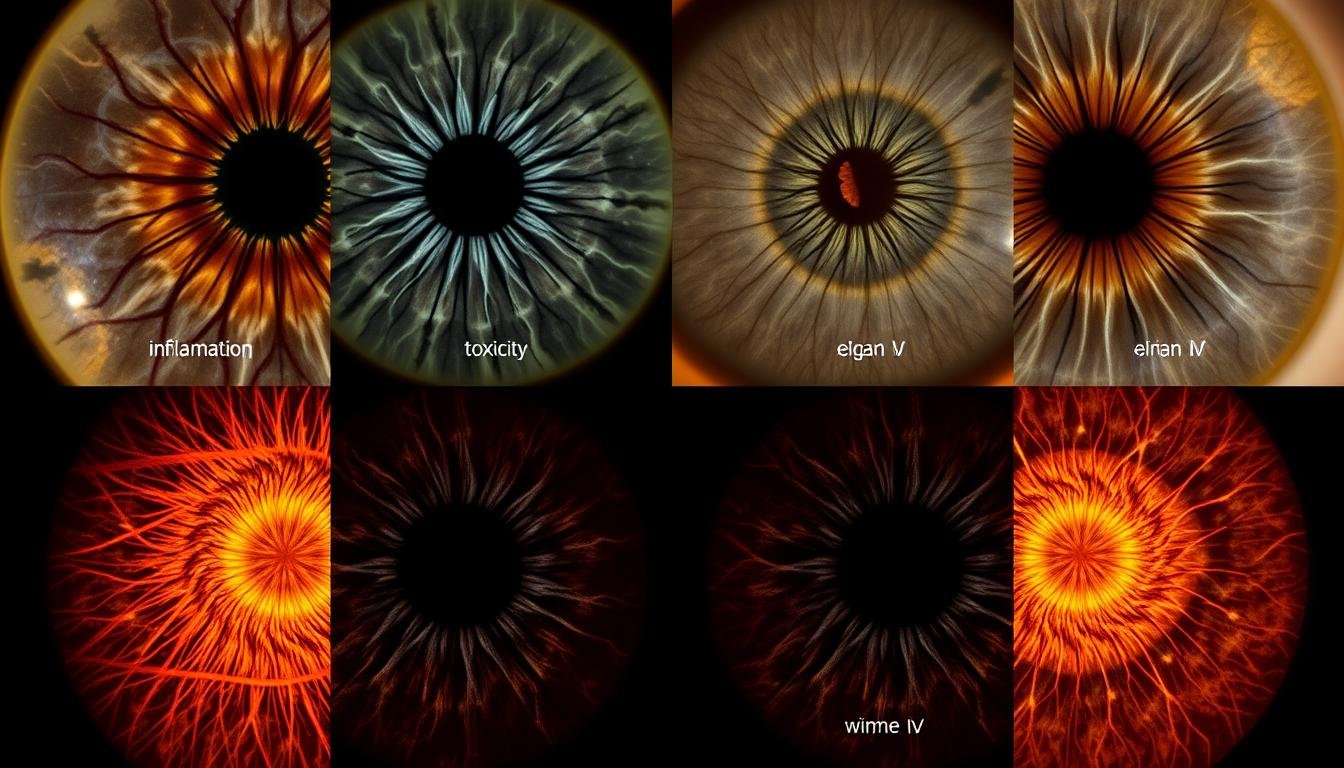
Comparison of iris patterns showing what iridologists interpret as indicators of health status
Common Health Issues Supposedly Revealed Through Iridologia
Organ Function
- Liver dysfunction
- Kidney stress
- Digestive disorders
- Heart weaknesses
- Lung conditions
Systemic Conditions
- Inflammation throughout the body
- Toxin accumulation
- Congestione del sistema linfatico
- Circulatory issues
- Hormonal imbalances
General Health Indicators
- Nutritional deficiencies
- Stress levels and location
- Genetic predispositions
- Past injuries or traumas
- Overall constitutional strength
Iridologists also claim they can detect health issues before symptoms appear, suggesting that changes in the iris precede the development of physical symptoms. This claim of early detection is particularly appealing to those interested in preventive health approaches.
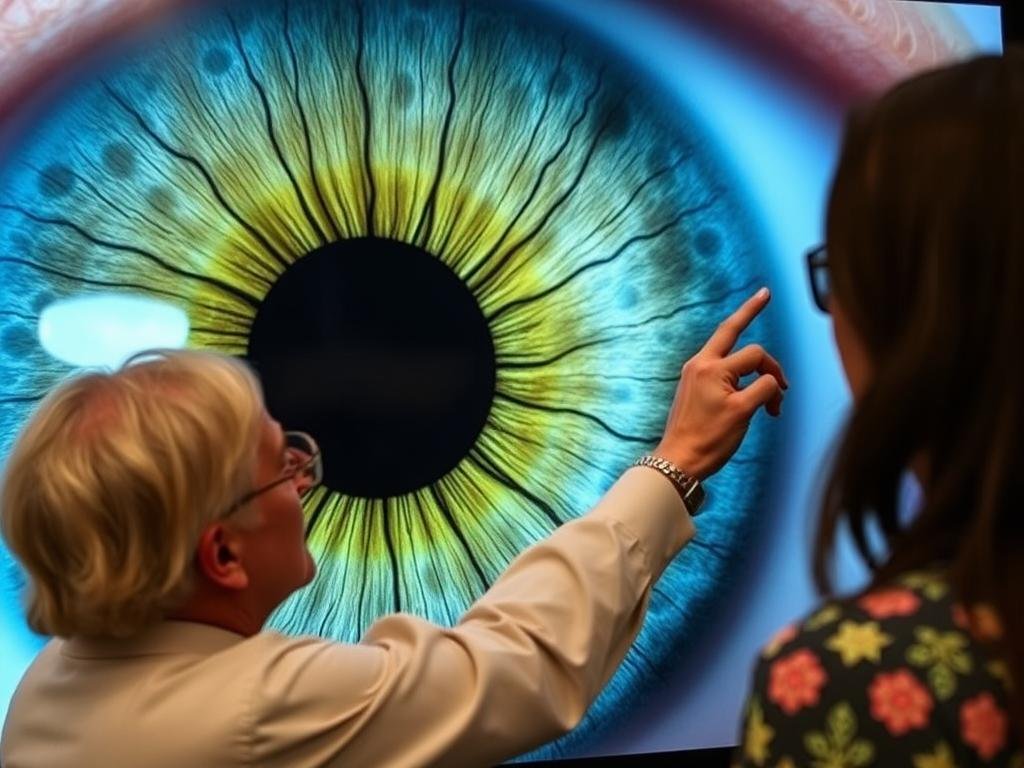
An iridologist identifying specific iris markings and explaining their interpretation
It’s important to note that while iridologists make these claims, the ability to diagnose specific health conditions through iris examination has not been validated by scientific research, as we’ll explore in the next section.
Discover What Your Iris May Reveal About Your Health
Curious about what your iris patterns might indicate? Schedule a consultation with a certified iridologist for a personalized assessment and health insights.
Find a Certified Iridologist
Criticisms and Controversies Surrounding Iridologia
Despite its long history and continued practice, Iridologia has been subject to scientific scrutiny, with most research failing to support its fundamental claims. Understanding the scientific perspective helps provide a balanced view of this alternative practice.
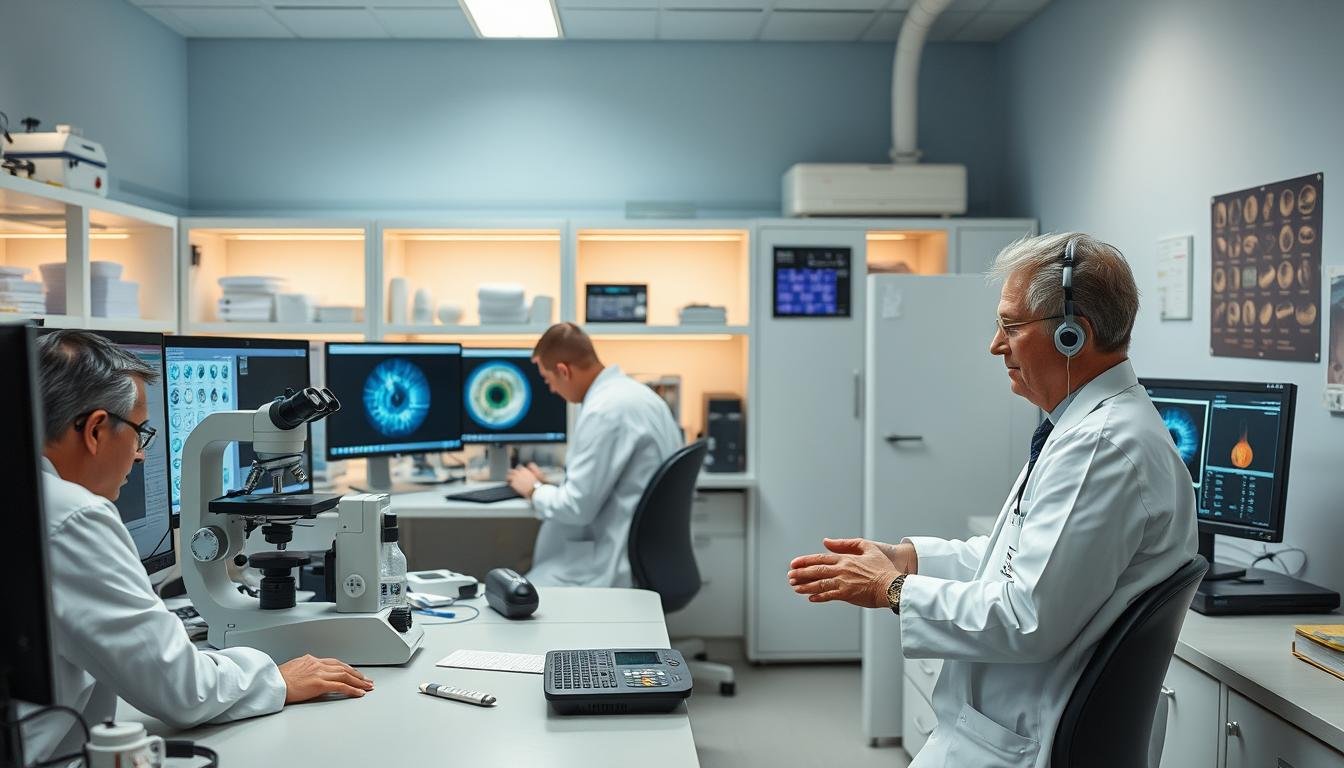
Scientific research examining the validity of iridology claims
Research Studies and Their Findings
Several controlled studies have investigated the diagnostic accuracy of Iridologia:
- A systematic review published in 1999 in the journal Forsch Komplementärmed examined four case-control studies and concluded that iridology’s efficacy was not supported by scientific evaluations.
- A study published in 2000 in the Archives of Ophthalmology found that iridologists could not consistently detect kidney disease through iris examination.
- Research published in the Journal of Alternative and Complementary Medicine failed to find evidence that iridologists could accurately diagnose gallbladder disease by examining the iris.
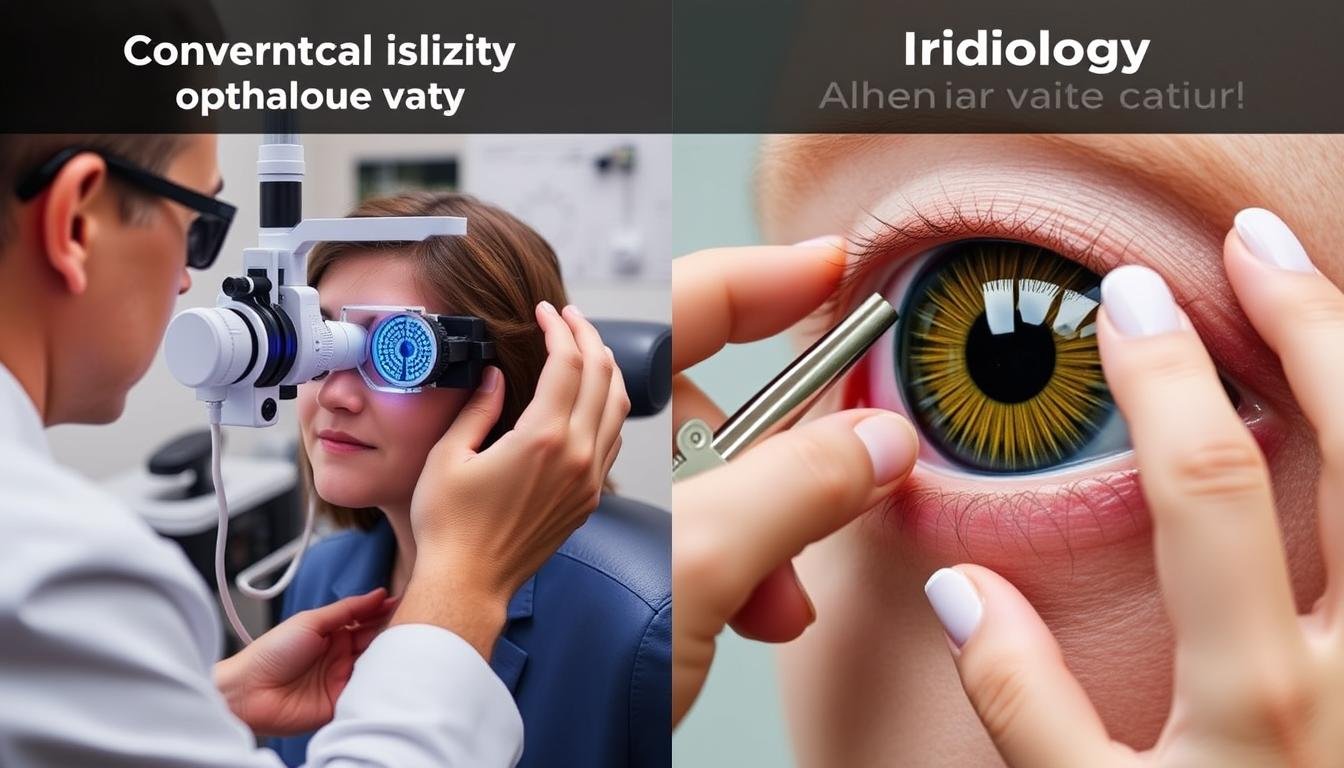
Comparison between conventional medical eye examination and iridology assessment
Most scientific studies have concluded that Iridologia has shown little to no diagnostic value when tested under controlled conditions. Researchers have consistently found that iridologists cannot reliably identify people with specific diseases by examining their irises.
Medical Community Perspective
The mainstream medical community generally does not support Iridologia as a diagnostic tool for several reasons:
Scientific Concerns About Iridology
- Lack of anatomical connection between the iris and most body organs
- Absence of a physiological mechanism to explain how internal organ conditions would affect iris appearance
- Inconsistent results when multiple iridologists examine the same patient
- Failure to demonstrate diagnostic accuracy in controlled studies
- The iris structure is largely determined by genetics and remains relatively stable throughout life
Medical professionals express concern that reliance on Iridologia for diagnosis could potentially lead to delayed treatment of serious conditions if patients forego conventional medical diagnosis in favor of iridology readings.
While the scientific consensus does not support Iridologia as a diagnostic method, some researchers suggest that further studies with improved methodology could be valuable to fully evaluate any potential correlations between iris features and health conditions.
Modern Applications of Iridologia in Holistic Health
Despite the lack of scientific validation, Iridologia continues to be practiced in various parts of the world, particularly within holistic and alternative health communities. Understanding its contemporary applications provides insight into why some people still seek out this practice.

Modern iridology practice in a contemporary holistic health setting
Integration with Holistic Health Practices
In today’s wellness landscape, Iridologia is often integrated with other alternative and complementary health approaches:
- As part of naturopathic assessments to guide treatment recommendations
- In conjunction with nutritional counseling to suggest dietary modifications
- Alongside herbal medicine to inform herbal prescriptions
- Within holistic health evaluations that include multiple assessment methods
- As a complementary tool in some integrative medicine practices
Practitioners who use Iridologia today often view it as one tool among many for assessing overall health patterns rather than as a definitive diagnostic method for specific diseases.
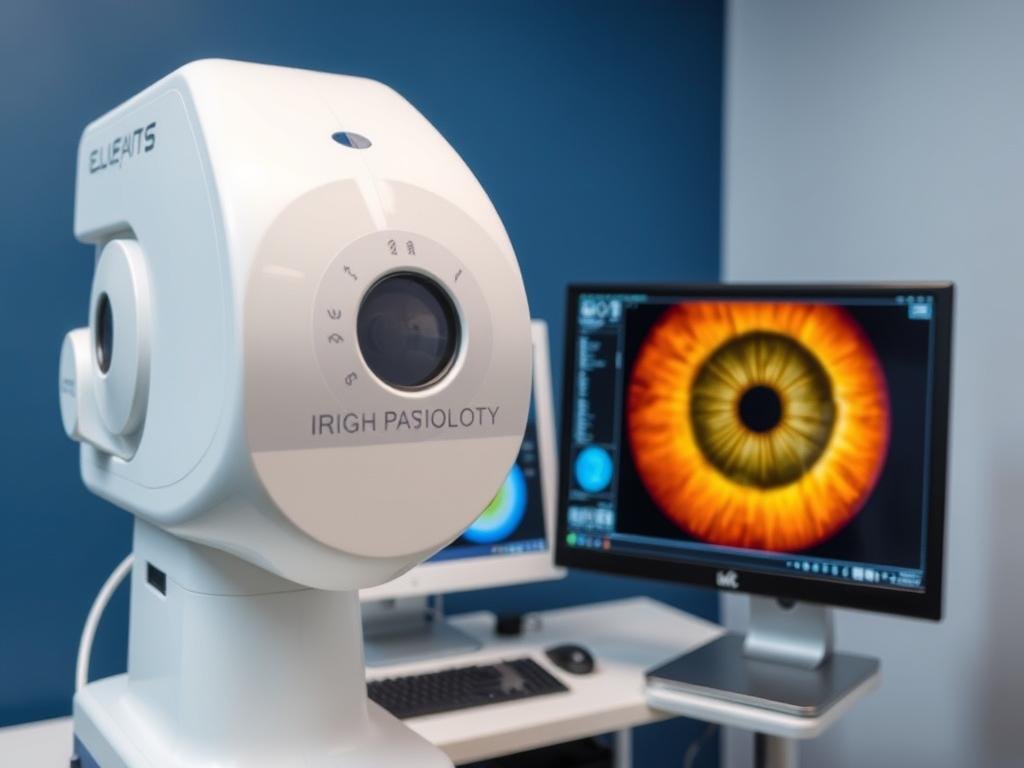
Modern digital technology used in contemporary iridology practice
Progressi tecnologici
Technology has influenced how Iridologia is practiced in the 21st century:
- High-resolution digital cameras capture detailed iris images
- Specialized software programs analyze iris patterns and markings
- Online platforms offer remote iridology consultations
- Mobile applications allow for preliminary iris analysis
These technological advancements have made Iridologia more accessible but haven’t necessarily increased its diagnostic accuracy according to scientific standards.
Enhance Your Holistic Health Practice
For health practitioners interested in adding iridology to their skill set, our comprehensive certification program provides the training and tools you need.
Explore Certification Programs
Case Studies: Iridologia in Practice
While scientific validation remains limited, proponents of Iridologia often cite case studies to demonstrate its potential value in health assessment. These examples provide insight into how practitioners apply iridology principles in real-world scenarios.
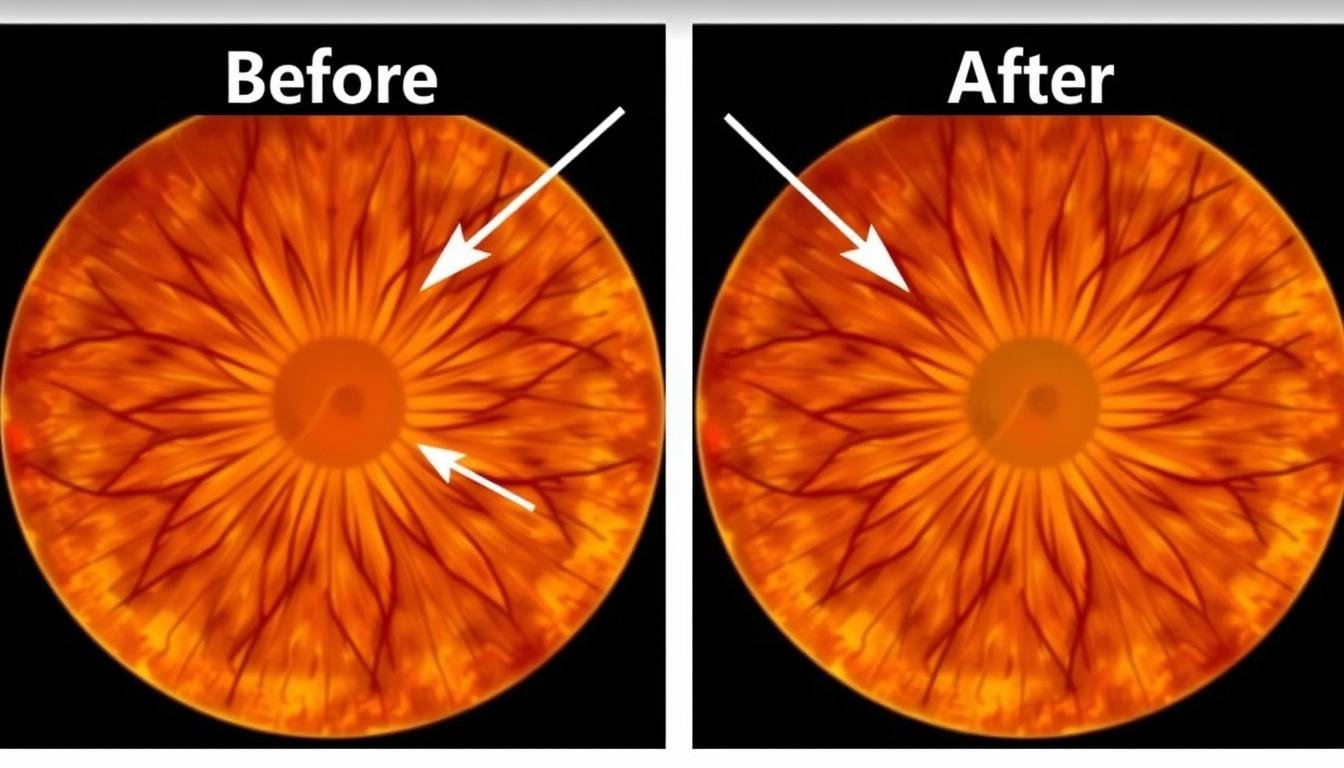
Before and after iris images showing changes following health interventions according to iridology practitioners
Case Study 1: Digestive System Assessment
A 42-year-old woman consulted an iridologist after experiencing chronic digestive issues that conventional testing had not fully explained. The iridologist noted specific markings in the digestive zone of her iris that suggested inflammation and potential food sensitivities. Based on these observations, the practitioner recommended an elimination diet and specific herbal supplements.
The client reported improvement in her symptoms after following the recommendations for three months. While this outcome cannot definitively be attributed to the accuracy of the iridology assessment, it represents the type of anecdotal evidence often cited by practitioners.
Case Study 2: Early Detection Claims

Iris photograph with markings indicating potential health concerns according to iridology interpretation
A 55-year-old man underwent routine iridology screening as part of a holistic health check. The iridologist identified markings in the area corresponding to the cardiovascular system and suggested the client might be experiencing early cardiovascular stress, despite having no symptoms. The client followed up with conventional medical testing, which revealed moderately elevated blood pressure and cholesterol levels that had not been previously diagnosed.
While conventional screening would likely have detected these issues eventually, proponents suggest this case demonstrates how Iridologia might complement traditional healthcare by encouraging preventive testing.
It’s important to note that these case studies represent anecdotal evidence rather than controlled scientific research. The positive outcomes could be attributed to various factors, including the placebo effect, lifestyle changes recommended alongside the iridology assessment, or coincidental timing.
Frequently Asked Questions About Iridologia
Is iridology the same as a regular eye exam?
No, Iridologia is fundamentally different from a conventional eye examination. A regular eye exam performed by an optometrist or ophthalmologist focuses on assessing vision and detecting eye diseases such as glaucoma, cataracts, or macular degeneration. These professionals use standardized, scientifically validated methods to evaluate eye health and vision.
Iridologia, in contrast, involves examining the iris to allegedly determine the health status of other body organs and systems—not to diagnose eye conditions themselves. While a conventional eye exam has proven diagnostic value and is an essential part of healthcare, Iridologia lacks scientific validation for its claims about diagnosing non-ocular health conditions.
Can iridology detect serious diseases like cancer?
There is no scientific evidence supporting the claim that Iridologia can detect cancer or other serious diseases. Multiple controlled studies have failed to demonstrate that iridologists can reliably identify specific diseases through iris examination.
For serious conditions like cancer, it’s crucial to rely on evidence-based medical diagnostic methods such as imaging studies, biopsies, blood tests, and physical examinations performed by qualified healthcare professionals. Delaying conventional medical diagnosis and treatment while relying on Iridologia could potentially lead to worse health outcomes for serious conditions.
What qualifications do iridologists typically have?
The qualifications of iridologists vary widely as there is no standardized, universally recognized certification or licensing specifically for Iridologia in most countries. Some practitioners may have completed courses or certification programs in Iridologia offered by various schools or organizations dedicated to alternative medicine. These programs can range from brief weekend courses to more extensive training programs.
Some iridologists may also be licensed healthcare practitioners such as naturopathic doctors, chiropractors, or acupuncturists who have added Iridologia to their practice. Others may have no formal healthcare training at all. When considering consulting an iridologist, it’s advisable to inquire about their specific training, approach, and whether they recommend Iridologia as a complement to, rather than a replacement for, conventional medical care.
How much does an iridology consultation typically cost?
The cost of an Iridologia consultation varies widely depending on the practitioner’s experience, location, and whether the session includes additional services such as nutritional counseling or supplement recommendations. Generally, prices range from to 0 for an initial consultation, which typically lasts 30-90 minutes.
Follow-up sessions are usually less expensive, ranging from to 0. Some practitioners may offer package deals that include the initial consultation, follow-up visits, and personalized health plans. It’s important to note that Iridologia consultations are rarely covered by health insurance, so these costs are typically out-of-pocket expenses.

A balanced approach to health combines conventional care with holistic awareness
Conclusion: The Place of Iridologia in Modern Health Practices
Iridologia presents an intriguing concept—that the iris might serve as a window into our overall health. While the practice has a long history and continues to attract interest, particularly in holistic health communities, it’s important to approach it with an informed perspective.
The scientific evidence does not currently support Iridologia as a reliable diagnostic method. Multiple controlled studies have failed to demonstrate that iridologists can consistently identify specific health conditions through iris examination. The medical community generally views Iridologia as lacking scientific foundation and potentially problematic if it leads people to delay seeking conventional medical care for serious conditions.
However, for those interested in holistic approaches to health, Iridologia might be viewed as one of many tools for general health assessment rather than as a definitive diagnostic technique. Some find value in the holistic perspective it offers, even if specific diagnostic claims remain unproven.
If you’re curious about Iridologia, consider these balanced recommendations:
- Approach Iridologia as a complementary tool rather than a replacement for conventional medical diagnosis
- Maintain regular check-ups with qualified healthcare providers
- Be skeptical of definitive health diagnoses made solely through iris examination
- Research the qualifications and approach of any iridology practitioner you consider consulting
- Consider the potential value of the holistic health conversation that might arise from an iridology session, even if specific diagnostic claims are viewed critically
Ultimately, your health deserves a comprehensive approach that considers evidence-based practices while remaining open to the potential insights that various perspectives might offer. The eyes are indeed remarkable organs—worthy of care, protection, and perhaps even a bit of wonder—regardless of one’s view on Iridologia.
Esplora ulteriormente l'iridologia
Whether you’re a healthcare professional looking to expand your knowledge or an individual interested in holistic health approaches, we offer resources to deepen your understanding of iridology.































